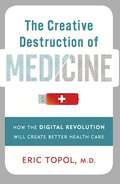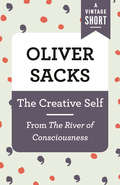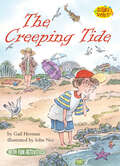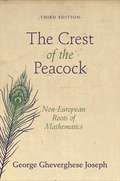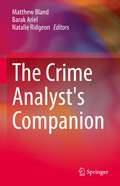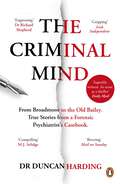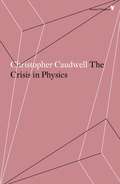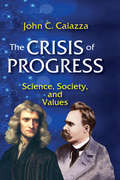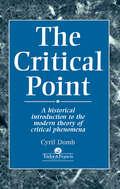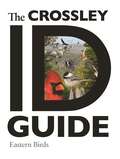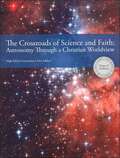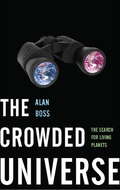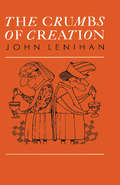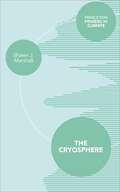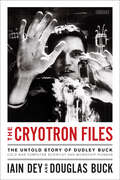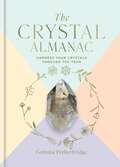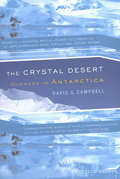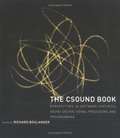- Table View
- List View
The Creative Brain: The Science of Genius
by Nancy C. AndreasenShakespeare's tragic plays, Mozart's sublime symphonies, and Einstein's revolutionary theories-how did these geniuses create such magnificent and highly original works? Were their brains different from those of ordinary people? Using modern neuroscience together with first-person accounts of creative breakthroughs from artists and scientists such as Mozart, Henri Poincare, and Neil Simon, The Creative Brain illuminates where extraordinary creativity comes from. Acclaimed brain scientist Nancy Andreasen proposes that, due to enriched connections between certain areas of the brain, geniuses are able to tap into the unconscious mind in ways that most of us can't. She also explores the link between creativity and mental illness, and she shows how all of us can enhance our creative potential through mental exercises. Clearly and accessibly written, The Creative Brain is a fascinating investigation into the mystery of human genius.
The Creative Destruction of Medicine: How the Digital Revolution Will Create Better Health Care
by Eric TopolWhat if your cell phone could detect cancer cells circulating in your blood or warn you of an imminent heart attack? Mobile wireless digital devices, including smartphones and tablets with seemingly limitless functionality, have brought about radical changes in our lives, providing hyper-connectivity to social networks and cloud computing. But the digital world has hardly pierced the medical cocoon. Until now. Beyond reading email and surfing the Web, we will soon be checking our vital signs on our phone. We can already continuously monitor our heart rhythm, blood glucose levels, and brain waves while we sleep. Miniature ultrasound imaging devices are replacing the icon of medicine--the stethoscope. DNA sequencing, Facebook, and the Watson supercomputer have already saved lives. For the first time we can capture all the relevant data from each individual to enable precision therapy, prevent major side effects of medications, and ultimately to prevent many diseases from ever occurring. And yet many of these digital medical innovations lie unused because of the medical community's profound resistance to change. In The Creative Destruction of Medicine, Eric Topol--one of the nation's top physicians and a leading voice on the digital revolution in medicine--argues that radical innovation and a true democratization of medical care are within reach, but only if we consumers demand it. We can force medicine to undergo its biggest shakeup in history. This book shows us the stakes--and how to win them.
The Creative Process: Perspectives from Multiple Domains (Palgrave Studies in Creativity and Culture)
by Todd LubartThe creative process refers to the sequence of thoughts and actions that are involved in the production of new work that is both original and valuable in its context. This book examines this process across the domains of visual art, writing, engineering, design and music. It characterizes each domain’s creative process based on evidence stemming from creators’ accounts of their own activity and a wide-range of observational material and theories specific to each field. Results from empirical research are then presented across a set of closely linked chapters, using a common set of methodologies that seek to trace the creative process as it unfolds. This highly interdisciplinary edited collection offers valuable insight into the creative process for scholars and practitioners in the fields of psychology, education, and creative studies, as well as for any other readers interested in the creative process. Todd Lubart brings together a group of authors who are themselves actively involved in their respective creative fields and invites readers to adopt a broad perspective on the creative process in order to unravel some of its mysteries.
The Creative Self: From The River of Consciousness (A Vintage Short)
by Oliver SacksA Vintage Shorts selection. Susan Sontag read voraciously. Alexander Pope wrote “Imitations of English Poets.” Henri Poincaré sought distraction from the mathematical problems that occupied his mind. In these and other fascinating case studies, bestselling author Oliver Sacks seeks answers to the question of how creativity can be kindled and encouraged in a person's life. Imbued with the passion and keen insight that made Sacks beloved to countless readers, this selection from The River of Consciousness will be of eager interest to all those with zeal for creative pursuit. An ebook short.
The Creator and the Cosmos: An Astrophysicist Reconciles Science and Scripture
by Hugh RossFew eternal themes intrigue individuals - believers and nonbelievers alike more than the mystery of creation and the Being of an eternal God.. Dr. Hugh Ross, a highly qualified and gifted cosmologist (a student of the universe) and astronomer/scientist gives us in this magnificent book irrefutable evidences of God's present and powerful working in His created universe. Most helpfully it is written in language readily understandable by those of us who are laypeople in the field of astrophysics. This is must reading for the seeking mind and heart.
The Creature Department
by Robert Paul Weston Framestore"Stunning...a bit like if you took Charlie and the Chocolate Factory and Monsters Inc. and shoved them in a TARDIS." --Buzzfeed It's a tentacled, inventive, gooey, world in there. . . . Elliot Von Doppler and his friend Leslie think nothing ever happens in Bickleburgh, except inside the gleaming headquarters of DENKi-3000--the world's eighth-largest electronics factory. Beneath the glass towers and glittering skywalks, there's a rambling old mansion from which all the company's amazing inventions spring forth. And no one except Uncle Archie knows what's behind the second-to-last door at the end of the hall. Until Elliot and Leslie are invited to take a glimpse inside. They find stooped, troll-like creatures with jutting jaws and broken teeth. Tiny winged things that sparkle as they fly. And huge, hulking, hairy nonhumans (with horns). It is unlike anything they've ever seen. But when Chuck Brickweather threatens to shut down the DENKi-3000 factory if a new product isn't presented soon, the creatures know they are in danger. And when Uncle Archie vanishes, it's up to Elliot, Leslie, and every one of the unusual, er, "employees" to create an invention so astonishing it will save the Creature Department.
The Creeping Tide (Science Solves It!)
by Gail HermanSolve kid-sized dilemmas and mysteries with the Science Solves It! series. These fun books for kids ages 5–8 blend clever stories with real-life science. Why did the dog turn green? Can you control a hiccup? Is that a UFO? Find the answers to these questions and more as kid characters dive into physical, life, and earth sciences. Missing sunglasses? Stolen sunscreen? And the beach blanket is sandy and wet! Can Jack solve the mystery and find out what is going on? Books in this perfect STEM series will help kids think like scientists and get ahead in the classroom. Activities and experiments are included in every book! (Level One; Science topic: Tides)
The Crest of the Peacock
by George Gheverghese JosephFrom the Ishango Bone of central Africa and the Inca quipu of South America to the dawn of modern mathematics, The Crest of the Peacock makes it clear that human beings everywhere have been capable of advanced and innovative mathematical thinking. George Gheverghese Joseph takes us on a breathtaking multicultural tour of the roots and shoots of non-European mathematics. He shows us the deep influence that the Egyptians and Babylonians had on the Greeks, the Arabs' major creative contributions, and the astounding range of successes of the great civilizations of India and China. The third edition emphasizes the dialogue between civilizations, and further explores how mathematical ideas were transmitted from East to West. The book's scope is now even wider, incorporating recent findings on the history of mathematics in China, India, and early Islamic civilizations as well as Egypt and Mesopotamia. With more detailed coverage of proto-mathematics and the origins of trigonometry and infinity in the East, The Crest of the Peacock further illuminates the global history of mathematics.
The Crime Analyst's Companion
by Barak Ariel Matthew Bland Natalie RidgeonThis volume presents a collection of essays from experienced crime analysts from around the world. It explores themes relevant to anyone embarking on, or already into a career in crime analysis. Divided into two sections, this book addresses technical issues central to the profession, from collection of data to presenting findings to reluctant audiences. It incorporates a collection of methodological case studies, demonstrating the ways analysis has made a meaningful difference to policing and security. This volume is intended for scholars who study and work with crime analysts, the global community of undergraduate and graduate students who may take one of these roles in the future, and law enforcement.
The Criminal Mind: Gripping encounters with serial killers and true crime from Britain's leading forensic psychiatrist
by Dr Duncan HardingWHAT MAKES A MURDERER? Unraveling the Dark Psychology Behind Britain’s Most Notorious Killers From Forensic Psychiatrist, Dr Duncan HardingSHORTLISTED FOR THE CWA ALCS GOLD DAGGER FOR NON-FICTION 2025'Grips you from the start like a bestselling novel then takes you on an extraordinary journey … Riveting’ JOHN HUMPHRYS'Incisive, informative and occasionally shocking, The Criminal Mind is an engrossing book’ DR RICHARD SHEPHERD, bestselling author of Unnatural Causes'A penetrating insight into the darkest corners of the human mind. The most moving, surprising and compelling book you’ll read this year’ M.J. ARLIDGE, bestselling author of Eeny Meeny–A young girl burns down the family homeA man doesn’t remember killing his wifeA teenager’s visions and voices lead to murderOne question binds these and many others from the casebook of Britain’s leading forensic psychiatrist: Why? What drives a person to commit seemingly inexplicable crimes?Dr Duncan Harding is the person the police and the courts turn to for answers – to establish a defendant’s mental state and motivation: their fitness to stand trial.It is a career that has brought him face to face with psychopaths, taken him to the limits of human compassion and to the darkest corners of his own troubled past.This then is a journey deep into the criminal mind . . .–PRAISE FOR THE CRIMINAL MIND'Not just another forensic psychiatrist’s casebook. . . . a moving account of how Harding became a child and adolescent forensic psychiatrist, caring for mentally disordered child and adolescent offenders' KEITH RIX professor of medical jurisprudence and forensic psychiatrist‘Superbly written, as tense as a thriller, this is a book that will make you miss the bus so gripping are these cases’ Daily Mail‘Harding’s riveting memoir is often very moving … it left me with a powerful respect for all the people in the health and justice systems who put their lives on the line to keep us safe’ MAIL ON SUNDAY‘A combination of medical coming-of-age tale and true crime that is particularly gripping … Harding writes with empathy and insight … each patient a mystery to unpick’ IRISH INDEPENDENT‘A fantastic read … a very accessible window into the darker recesses of human behaviour … hard to put down’ JUDGE DAVID WILLIAMS‘Not just another forensic psychiatrist’s casebook, but a moving account of how Duncan Harding became forensic psychiatrist’ KEITH RIX, PROFESSOR IN FORENSIC PSYCHIATRY
The Crisis in Physics
by Christopher CaudwellCaudwell’s controversial book offers an astute and enduring diagnosis of the maladies of bourgeois epistemology.
The Crisis of Progress: Science, Society, and Values
by John C. CaiazzaThis book is about the concept of progress, its separate varieties, its current rejection, and how it may be reconsidered from a philosophical and scientific basis. John C. Caiazza's main emphasis is on how science is understood as it has a direct impact on social values as expressed by prominent philosophers. He argues that progress is at a standstill, which presents a crisis for Western civilization.Caiazza presents historical examples, both of scientific inquiry and social and cultural themes, to examine the subject of progress. Beginning with the Whig model and progressive political values exemplified by Bacon and Dewey, he also examines other variations, the Enlightenment, cosmopolitanism, and totalitarianism. Technology, argues Caiazza, also has a stultifying effect on Western culture and to understand the idea of progress, we must take a philosophic rather than a scientific point of view. Modern cosmology has inevitable humanistic and theological implications, and major contemporary philosophers reject social science in favour of ancient concepts of virtue and ethics.In the end, Caiazza writes that time is an agent, not a neutral plain on which scientific and historical events occur. We can expect technology to keep us in stasis or become aware of the possibility of transcendence. This book will be of interest for students of scientific history and philosophy.
The Critical Point: A Historical Introduction To The Modern Theory Of Critical Phenomena
by C DombThe relationship between liquids and gases engaged the attention of a number of distinguished scientists in the mid 19th Century. In a definitive paper published in 1869, Thomas Andrews described experiments he performed on carbon dioxide and from which he concluded that a critical temperature exists below which liquids and gases are distinct phase
The Crossley ID Guide: Eastern Birds (The Crossley ID Guides)
by Richard CrossleyA revolution in birding and field guidesThis stunningly illustrated book from acclaimed birder and photographer Richard Crossley revolutionizes field guide design by providing the first real-life approach to identification. Whether you are a beginner, expert, or anywhere in between, The Crossley ID Guide will vastly improve your ability to identify birds.Unlike other guides, which provide isolated individual photographs or illustrations, this is the first book to feature large, lifelike scenes for each species. These scenes—640 in all—are composed from more than 10,000 of the author's images showing birds in a wide range of views--near and far, from different angles, in various plumages and behaviors, including flight, and in the habitat in which they live. These beautiful compositions show how a bird's appearance changes with distance, and give equal emphasis to characteristics experts use to identify birds: size, structure and shape, behavior, probability, and color. This is the first book to convey all of these features visually--in a single image--and to reinforce them with accurate, concise text. Each scene provides a wealth of detailed visual information that invites and rewards careful study, but the most important identification features can be grasped instantly by anyone.By making identification easier, more accurate, and more fun than ever before, The Crossley ID Guide will completely redefine how its users look at birds. Essential for all birders, it also promises to make new birders of many people who have despaired of using traditional guides.Revolutionary. This book changes field guide design to make you a better birderA picture says a thousand words. The most comprehensive guide: 640 stunning scenes created from 10,000 of the author's photographsReality birding. Lifelike in-focus scenes show birds in their habitats, from near and far, and in all plumages and behaviorsTeaching and reference. The first book to accurately portray all the key identification characteristics: size, shape, behavior, probability, and colorPractice makes perfect. An interactive learning experience to sharpen and test field identification skillsBird like the experts. The first book to simplify birding and help you understand how to bird like the bestAn interactive website—www.crossleybirds.com—includes expanded captions for the plates and species updates
The Crossroads of Science and Faith: Astronomy Through a Christian Worldview
by Susan Benecchi Paula Gossard Gladys KoberThis textbook is designed to be a resource for the Christian community (for both the home school environment and Christian schools) to teach Astronomy and introduce students to the science & faith dialog. The materials in this textbook will strengthen students' faith and prepare them to face a secular university or world environment with confidence. It is designed to equip them to defend their faith with good reasoning and to make them ready to engage unbelievers in respectful discussions. The textbook also encourages the search for truth in every area and promotes dialogue and integration between science and faith while also offering a Christian worldview, where God is the Author, Creator, and Designer of this mind-boggling and awesome universe. The textbook includes many interviews with professional Christian astronomers that we hope will inspire and encourage students and parents alike.
The Crowded Greenhouse: Population, Climate Change, and Creating a Sustainable World
by John Firor Judith JacobsenWhat is the best way to move our planet to a safe and sustainable future? This book focuses on two global issues - rapid population growth and a human-induced climate change caused by emissions - that lie at the heart of this problem. John Firor and Judith Jacobsen summarize the current status of these two issues, show how they are related to one another, and prescribe steps that governments, economies, societies, and individuals can adopt to ensure their stability." --BOOK JACKET. Title Summary field provided by Blackwell North America, Inc. All Rights Reserved
The Crowded Universe: The Search for Living Planets
by Alan BossWe are nearing a turning point in our quest for life in the universe-we now have the capacity to detect Earth-like planets around other stars. But will we find any? In The Crowded Universe, renowned astronomer Alan Boss argues that based on what we already know about planetary systems, in the coming years we will find abundant Earths, including many that are indisputably alive. Life is not only possible elsewhere in the universe, Boss argues-it is common. Boss describes how our ideas about planetary formation have changed radically in the past decade and brings readers up to date on discoveries of bizarre inhabitants of various solar systems, including our own. America must stay in this new space race, Boss contends, or risk being left out of one of the most profoundly important discoveries of all time: the first confirmed finding of extraterrestrial life.
The Cruelest Miles: The Heroic Story of Dogs and Men in a Race Against an Epidemic
by Laney Salisbury Gay Salisbury"A stirring tale of survival, thanks to man's best friend . . . reflects a transcendent understanding and impeccable research."--Seattle Times When a deadly diphtheria epidemic swept through Nome, Alaska, in 1925, the local doctor knew that without a fresh batch of antitoxin, his patients would die. The lifesaving serum was a thousand miles away, the port was icebound, and planes couldn't fly in blizzard conditions--only the dogs could make it. The heroic dash of dog teams across the Alaskan wilderness to Nome inspired the annual Iditarod Trail Sled Dog Race and immortalized Balto, the lead dog of the last team whose bronze statue still stands in New York City's Central Park. This is the greatest dog story, never fully told until now.
The Crumbs of Creation: Trace elements in history, medicine, industry, crime and folklore
by J LenihanOf the 90 chemical elements that occur in nature, only a dozen are found in easily measurable amounts in the human body. The rest are trace elements, present at such low concentrations that most of them were, until quite recently, beyond the reach of detection. The Crumbs of Creation reviews the absorbing story of trace elements in medicine, history, industry, crime, and folklore, showing how the study of their properties can help us survive through a better understanding and control of our environment. Written in an easy-to-read, entertaining style, the book consists of interrelated anecdotes grouped together in relevant chapters. Although readers will derive much entertainment from this book, there is an underlying seriousness to the topics.
The Cryosphere (Princeton Primers in Climate #4)
by Shawn J. MarshallThe cryosphere encompasses the Earth's snow and ice masses. It is a critical part of our planet's climate system, one that is especially at risk from climate change and global warming. The Cryosphere provides an essential introduction to the subject, written by one of the world's leading experts in Earth-system science. In this primer, glaciologist Shawn Marshall introduces readers to the cryosphere and the broader role it plays in our global climate system. After giving a concise overview, he fully explains each component of the cryosphere and how it works--seasonal snow, permafrost, river and lake ice, sea ice, glaciers, ice sheets, and ice shelves. Marshall describes how snow and ice interact with our atmosphere and oceans and how they influence climate, sea level, and ocean circulation. He looks at the cryosphere's role in past ice ages and considers the changing cryosphere's future impact on our landscape, oceans, and climate. Accessible and authoritative, this primer also features a glossary of key terms, suggestions for further reading, explanations of equations, and a discussion of open research questions in the field.
The Cryotron Files: The Untold Story Of Dudley Buck, Pioneer Computer Scientist And Cold War Government Agent
by Iain Dey Douglas BuckThe riveting true story of Dudley Buck, the American computer scientist whose pioneering work with microchips placed him firmly in the sights of the KGB Dr. Dudley Allen Buck was a brilliant young scientist on the cusp of fame and fortune when he died suddenly on May 21, 1959, at the age of 32. He was the star professor at MIT and had done stints with the NSA and Lockheed. His latest invention, the Cryotron—an early form of the microchip—was attracting attention all over the globe. It was thought that the Cryotron could guide a new generation of intercontinental ballistic missiles to their targets. Four weeks before Dudley Buck’s death, he was visited by a group of the Soviet Union’s top computer experts. On the same day that he died from a mysterious sudden bout of pneumonia, his close colleague, Dr. Louis Ridenour, was also found dead from similar causes. Two top American computer scientists had unexpectedly died young on the same day. Were their deaths linked? Two years old when his father died, Douglas Buck was never satisfied with the explanation of his father’s death and has spent more than 20 years investigating it, acquiring his father’s lab books, diaries, correspondence, research papers and patent filings. Armed with this research, award-winning journalist Iain Dey tells, with compelling immediacy, the story of Dudley Buck’s life and groundbreaking work, starting from his unconventional beginnings in California through to his untimely death and beyond. The Cryotron Files is at once the gripping narrative history of America and its computer scientists during the Cold War and the dramatic personal story of rising MIT star Dudley Buck in the high-stakes days of spies, supercomputers, and the space and nuclear race.
The Crystal Almanac: Harness Your Crystals Through the Year
by Gemma PetherbridgeEmbrace the energy of crystals throughout the changing seasonsThroughout the year, the energies around us vary dramatically. Working with crystals is all about bringing specific energies into our life, so it's important to be connected with these natural cycles, to ensure we're bringing balance, peace and healing into our lives in our crystal work.In The Crystal Almanac, certified Crystal Healer Gemma Petherbridge teaches you how the seasons might feel or play out, the emotional shifts that can happen throughout the year, and how changing energies can affect our mood, happiness and even our manifestation skills. Discover the Sabbats and celebrations, moon phases, astrological cycles and deities related to each season and learn how you can use this knowledge to support and enhance your crystal work. Featuring crystal activities tailored to every month, this book will help to bring you into alignment with the natural world.For each month you will discover:-A crystal to help you work with the elemental energies or an upcoming Sabbat celebration-A crystal to correspond with that month's astrological/lunar changes-A crystal that will allow you to call in a goddess and tap into her power-A crystal to summarise the month's overall themes and energies-Two activities to help you put your crystal work into practice
The Crystal Almanac: Harness Your Crystals Through the Year
by Gemma PetherbridgeEmbrace the energy of crystals throughout the changing seasonsThroughout the year, the energies around us vary dramatically. Working with crystals is all about bringing specific energies into our life, so it's important to be connected with these natural cycles, to ensure we're bringing balance, peace and healing into our lives in our crystal work.In The Crystal Almanac, certified Crystal Healer Gemma Petherbridge teaches you how the seasons might feel or play out, the emotional shifts that can happen throughout the year, and how changing energies can affect our mood, happiness and even our manifestation skills. Discover the Sabbats and celebrations, moon phases, astrological cycles and deities related to each season and learn how you can use this knowledge to support and enhance your crystal work. Featuring crystal activities tailored to every month, this book will help to bring you into alignment with the natural world.For each month you will discover:-A crystal to help you work with the elemental energies or an upcoming Sabbat celebration-A crystal to correspond with that month's astrological/lunar changes-A crystal that will allow you to call in a goddess and tap into her power-A crystal to summarise the month's overall themes and energies-Two activities to help you put your crystal work into practice
The Crystal Desert: Summers in Antarctica
by David G. CampbellThe acclaimed author and biologist shares “a superb personal account [of Antarctica] . . . a remarkable evocation of a land at the bottom of the world” (Boston Globe).During the 1980s, biologist David Campbell spent three summers in Antarctica, researching its surprisingly plentiful wildlife. In The Crystal Desert, he combines travelogue, nature writing and science history to tell the story of life's tenacity on the coldest of Earth's continents. Between scuba expeditions in Admiralty Bay, Campbell remembers the explorers who discovered Antarctica, the whalers and sealers who despoiled it, and the scientists who laid the groundwork to decipher its mysteries. Chronicling the desperately short summers in beautiful, lucid prose, he presents a fascinating portrait of the evolution of life in Antarctica and of the continent itself.Winner of the John Burroughs Medal for Natural History Writing and a Houghton Mifflin Literary Fellowship
The Csound Book: Perspectives in Software Synthesis, Sound Design, Signal Processing and Programming
by Richard BoulangerWritten by the world's leading educators, programmers, sound designers, and composers, this comprehensive guide covers both the basics of Csound and the theoretical and musical concepts necessary to use the program effectively.

